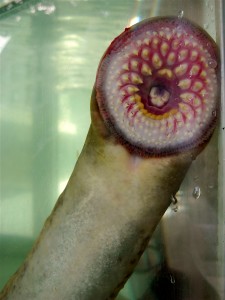TUESDAY, 12 OCTOBER 2010
The evolution of jaws around 480 million years ago represented a groundbreaking shift in vertebrate evolution, allowing predators the opportunity to catch and process large motile prey. The seas would never be as safe again.Researchers at the University of Colorado, Boulder, have proposed a new explanation for the paradigm-shifting development. Instead of the sudden appearance of jaw patterning, the team, headed by Daniel Medeiros, propose the pre-pattern/cooption model. This model shows that most of the patterning needed to make fully functional jaws is present in the jawless fish lampreys. In fact, the research suggests that changes in the expression of only three genes may have been the key to the development of jaws. These genes are responsible for patterning the dorso-ventral axis of the head region.
The team genetically analysed the jawless vertebrate lamprey (which has a similar skeleton structure to fossil jawless vertebrates). Ten genes were analysed using cloning and expression techniques in embryos. It was found that many of the characteristics essential for jaw development were present in the common ancestor of both jawed and jawless vertebrates. This means that forming a jaw from a jawless ancestor was a surprisingly simple step in terms of genetic change.
The findings are published in Proceedings of the National Academy of Sciences.
Written by Imogen Ogilvie

